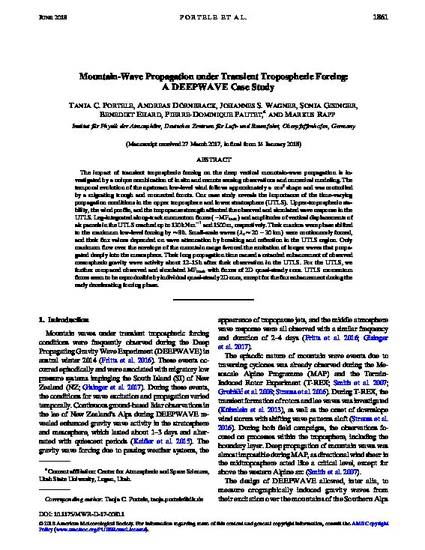
The impact of transient tropospheric forcing on the deep vertical mountain-wave propagation is investigated by a unique combination of in situ and remote sensing observations and numerical modeling. The temporal evolution of the upstream low-level wind follows approximately a cos2 shape and was controlled by a migrating trough and connected fronts. Our case study reveals the importance of the time-varying propagation conditions in the upper troposphere and lower stratosphere (UTLS). Upper-tropospheric stability, the wind profile, and the tropopause strength affected the observed and simulated wave response in the UTLS. Leg-integrated along-track momentum fluxes (-MFtrack) and amplitudes of vertical displacements of air parcels in the UTLS reached up to 130 kN m-1 and 1500 m, respectively. Their maxima were phase shifted to the maximum low-level forcing by ≈8 h. Small-scale waves (λx ≈ 20 - 30 km) were continuously forced, and their flux values depended on wave attenuation by breaking and reflection in the UTLS region. Only maximum flow over the envelope of the mountain range favored the excitation of longer waves that propagated deeply into the mesosphere. Their long propagation time caused a retarded enhancement of observed mesospheric gravity wave activity about 12–15 h after their observation in the UTLS. For the UTLS, we further compared observed and simulated MFtrack with fluxes of 2D quasi-steady runs. UTLS momentum fluxes seem to be reproducible by individual quasi-steady 2D runs, except for the flux enhancement during the early decelerating forcing phase.

© Copyright 2018 American Meteorological Society (AMS). Permission to use figures, tables, and brief excerpts from this work in scientific and educational works is hereby granted provided that the source is acknowledged. Any use of material in this work that is determined to be “fair use” under Section 107 of the U.S. Copyright Act or that satisfies the conditions specified in Section 108 of the U.S. Copyright Act (17 USC §108) does not require the AMS’s permission. Republication, systematic reproduction, posting in electronic form, such as on a website or in a searchable database, or other uses of this material, except as exempted by the above statement, requires written permission or a license from the AMS. All AMS journals and monograph publications are registered with the Copyright Clearance Center (http://www.copyright.com). Questions about permission to use materials for which AMS holds the copyright can also be directed to permissions@ametsoc.org. Additional details are provided in the AMS Copyright Policy statement, available on the AMS website (http://www.ametsoc.org/CopyrightInformation).